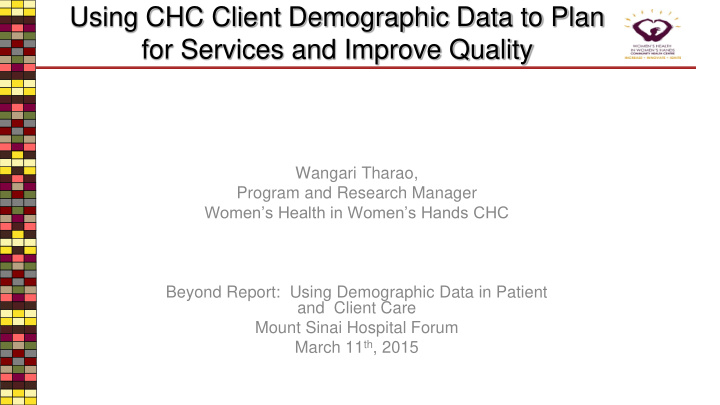



Using CHC Client Demographic Data to Plan for Services and Improve Quality Wangari Tharao, Program and Research Manager Women’s Health in Women’s Hands CHC Beyond Report: Using Demographic Data in Patient and Client Care Mount Sinai Hospital Forum March 11 th , 2015
Presentation outline • Mandate of WHIWH • Client Demographics • Data Linkage to Services: – Issues being addressed • Multiple co-morbidities – diabetes, mental health and HIV • Poverty • Increasing Access to Quality Care:Links to external research • Advocacy • Enhancing internal data through external research – Questions
Mandate Feminist, Pro-choice, anti-racist, and multi-lingual health center for women. Provision of primary healthcare services for black women and women of colour from the African, Caribbean, Latin American and South Asian communities in Toronto and surrounding areas Immigrant, refugee and non status women Diverse cultural and linguistic backgrounds over the age of 16 across the lifespan Women with disabilities
Client demographics: 32% 2% Active Clients 11% (n=2448) 6%
Sex: 100.00% 90.00% 80.00% 70.00% 60.00% 50.00% 40.00% 30.00% 20.00% 10.00% 0.00% Female Male Unknown 5
1. Top 5 Client Ethnicities Caribbean 32% Black 24% African 15% Latin American 11% South Asian 6% Hispanic 4%
Top 5 Spoken Languages: 90.00% 80.00% 70.00% 60.00% 50.00% 40.00% 30.00% 20.00% 10.00% 0.00% English Spanish; Castilian French Portuguese Swahili 7
Top 5 Places of Birth: 16.00% 14.00% 12.00% 10.00% 8.00% 6.00% 4.00% 2.00% 0.00% Saint Vincent and The Canada Jamaica Saint Lucia Mexico Grenadines 8
Age Range: 18.00% 16.00% 14.00% 12.00% 10.00% 8.00% 6.00% 4.00% 2.00% 0.00% 1-4 5-9 10-14 15-19 20-24 25-29 30-34 35-39 40-44 45-49 50-54 55-59 60-64 65+ 9
Education Levels: 45.00% 40.00% 35.00% 30.00% 25.00% 20.00% 15.00% 10.00% 5.00% 0.00% Post secondary or Secondary or Primary or equivalent Do not know No formal education Other Too young for primary equivalent equivalent (grades 9- (grades 1-8) completion 12) 10
Household Income: 70.00% 60.00% 50.00% 40.00% 30.00% 20.00% 10.00% 0.00% 11
Utilization of Demographic Data for Client Care:
T op 10 Issues Addressed WHIWH 2013 Statistics
Summary of Issues Demographics from Internal Data: • Over 73% living in poverty • 31% have mental health issues – 6% experiencing serious mental health related issues • 11% HIV/AIDS • 10% Co-Morbidities of HIV/Diabetes/Mental Health • 0.8% addictions • 40%+ uninsured • 27 % are women over 50 years • 70% are in their reproductive years (15 – 49 years)
Focus on 3 Chronic Diseases: • Current strategic plan is focusing on three Comorbidities - HIV; Mental health; and Diabetes – High quality; client centered; and evidence informed services • Three (3) Interdisciplinary teams (IDTs) have been established – Diabetes, Mental health and HIV/AIDS • Aims of the IDTs – Increase access to services – Increase capacity of staff to deliver effective and culturally appropriate services – Develop internal and external pathways of care and track them – Improve monitoring and evaluation of services provided and utilized by women – Support intervention development – Strengthen/Establish relevant partnerships to support identified aims
Addressing Poverty: • Accessible housing – Partnership with Fred Victor: – Housing worker comes once a week to work with women with housing issues • Emergency Foodbank – partnership with the Daily Bread Food Bank: – Food delivered twice a month • Facilitating access to care and services for women living with HIV: – Tokens and childcare to facilitate participation in community activities – Access to medication for women without legal status – Skills and capacity building support • Support to file immigration claims for women without status – partnership with a lawyer: – Pro-bono services provided – lawyer comes to WHIWH once a month
Increasing Access to Quality Care: • Uninsured Negotiations: • Negotiations with specialists (OB) and hospitals for delivery • Developing partnerships with midwifery practices • Mental Health Shared Care – partnership with a psychiatrist CAMH • Reduced emergency department usage by approx. 50% from 2009 – 2012 • CBT Partnership with CCVT and Sherbourne Health Centre to provide culturally specific CBT: • Women from war torn countries with experiences of multiple traumas pre and post migration 17
Advocacy to support Equity: • Raising the minimum wage: • Cuts to IFH • WHIWH has a local, national and international advocacy plan – AIM: to ensure equitable access and service delivery for immigrant, refugee and non status racialized women 18
External Research Macro Meso Micro Primary Health Care: Access and Utilization of Primary Health Care for Black Women and Women of Colour Knowledge Translation and Exchange Activities
QUESTIONS
Recommend
More recommend